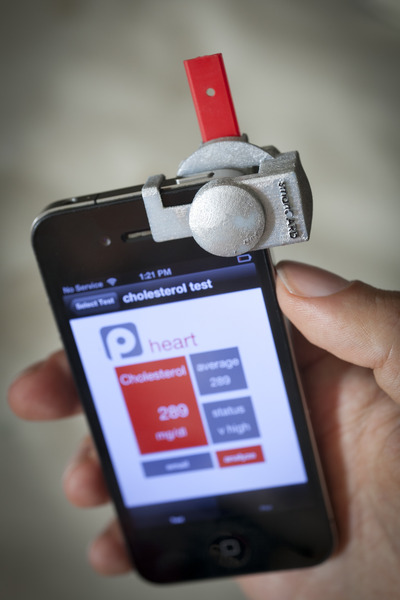Take a selfie of your cholesterol levels
Thursday, 19 December, 2013
Cornell University researchers have developed a new system which, when fitted over a smartphone, can be used to quickly and easily measure cholesterol levels. The method has been described in the journal Lab on a Chip.
“Home self-diagnostic tools for blood cholesterol monitoring have been around for over a decade,” said the study authors, “but their widespread adoption has been limited by the relatively high cost of acquiring a quantitative test-strip reader, complicated procedure for operating the device, and inability to easily store and process results.” With this in mind, the Cornell engineers created the Smartphone Cholesterol Application for Rapid Diagnostics, or ‘smartCARD’.

First the user puts a drop of blood on the accompanying cholesterol test strip, which processes the blood through separation steps and chemical reactions. The strip is then ready for colorimetric analysis by the smartCARD, which clamps over the phone’s camera. Its in-built flash provides uniform, diffused light to illuminate the test strip that fits into the smartCARD reader. The application in the phone calibrates the hue saturation to the image’s colour values on the test strip and the results appear on the phone.
“The system can accurately quantify total cholesterol levels in blood within 60 s,” the authors said. In future, the technology will break these levels into LDL (‘bad’ cholesterol), HDL (‘good’ cholesterol) and triglyceride measurements.
The ease of the technology, said senior author Associate Professor David Erickson, allows for users to gain a greater understanding of what their cholesterol levels are and how they can lower them, archiving the result before switching to healthier habits.
Erickson credits the success of the technology to the ever-increasing ubiquity of smartphones. By 2016 there’ll be 260 million active smartphones in the United States, he says; according to the study authors, this will “allow cholesterol monitoring to become more accurate and widespread, greatly improving preventive care for cardiovascular disease”.
Microplastics found to alter the human gut microbiome
Microplastic-treated cultures showed a consistent and significant increase in acidity (lower pH...
Sustainable, self-repairing, antimicrobial polymers developed
From medicine to electronics and optics, new materials developed by scientists at Kaunas...
A better way to create conductive polymers
New research disproves the longstanding belief that to create conductive polymers, substances...





